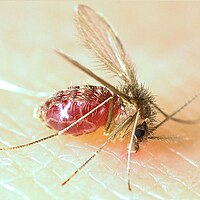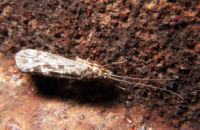
DNA barcoding of Lutzomyia longipalpis species complex (Diptera: Psychodidae), suggests the existence of 8 candidate species.
Sign Up to like & getrecommendations! Published in 2021 at "Acta tropica"
DOI: 10.1016/j.actatropica.2021.105983
Abstract: The sand fly Lutzomyia (L.) longipalpis has been implicated as the primary vector of Leishmania infantum, the causative agent of visceral leishmaniasis VL. In addition, it has been associated with atypical cutaneous leishmaniasis transmission in… read more here.
Keywords: dna barcoding; longipalpis species; barcoding lutzomyia; lutzomyia longipalpis ... See more keywords

Na+/K+-ATPase Activation by cAMP in the Midgut of Lutzomyia longipalpis (Lutz & Neiva, 1912; Diptera: Psychodidae)
Sign Up to like & getrecommendations! Published in 2022 at "Journal of Insect Science"
DOI: 10.1093/jisesa/ieac008
Abstract: Abstract Lutzomyia longipalpis (Lutz & Neiva, 1912) females have been intensively studied regarding the regulation of midgut pH. The mechanisms involved in pH regulation are complex, and some aspects remain to be clarified. Here, we… read more here.
Keywords: lutz neiva; neiva 1912; lutzomyia longipalpis; camp ... See more keywords

Characterisation of the glutathione S-transferase (GST) genes in the sand flies Phlebotomus papatasi and Lutzomyia longipalpis shows expansion of the novel GST Xi class.
Sign Up to like & getrecommendations! Published in 2022 at "Insect molecular biology"
DOI: 10.1111/imb.12769
Abstract: Leishmaniasis control often relies upon insecticidal control of phlebotomine sandfly vector populations. Such methods are vulnerable to the evolution of insecticide resistance via a range of molecular mechanisms. There is evidence that two major resistance… read more here.
Keywords: gst; resistance; phlebotomus papatasi; papatasi lutzomyia ... See more keywords

Structure of SALO, a leishmaniasis vaccine candidate from the sand fly Lutzomyia longipalpis
Sign Up to like & getrecommendations! Published in 2017 at "PLoS Neglected Tropical Diseases"
DOI: 10.1371/journal.pntd.0005374
Abstract: Background Immunity to the sand fly salivary protein SALO (Salivary Anticomplement of Lutzomyia longipalpis) protected hamsters against Leishmania infantum and L. braziliensis infection and, more recently, a vaccine combination of a genetically modified Leishmania with… read more here.
Keywords: protein; lutzomyia longipalpis; sand fly; fly ... See more keywords

Attraction of Lutzomyia longipalpis to synthetic sex-aggregation pheromone: Effect of release rate and proximity of adjacent pheromone sources
Sign Up to like & getrecommendations! Published in 2018 at "PLoS Neglected Tropical Diseases"
DOI: 10.1371/journal.pntd.0007007
Abstract: In South America, the Protist parasite that causes visceral leishmaniasis, a potentially fatal human disease, is transmitted by blood-feeding female Lutzomyia longipalpis sand flies. A synthetic copy of the male produced sex-aggregation pheromone offers new… read more here.
Keywords: sex aggregation; pheromone; rate; lutzomyia longipalpis ... See more keywords

Tripartite interactions: Leishmania, microbiota and Lutzomyia longipalpis
Sign Up to like & getrecommendations! Published in 2020 at "PLoS Neglected Tropical Diseases"
DOI: 10.1371/journal.pntd.0008666
Abstract: The microbial consortium associated with sandflies has gained relevance, with its composition shifting throughout distinct developmental stages, being strongly influenced by the surroundings and food sources. The bacterial components of the microbiota can interfere with… read more here.
Keywords: interactions leishmania; longipalpis; microbiota lutzomyia; tripartite interactions ... See more keywords

Effects of larval rearing substrates on some life-table parameters of Lutzomyia longipalpis sand flies.
Sign Up to like & getrecommendations! Published in 2021 at "PLoS neglected tropical diseases"
DOI: 10.1371/journal.pntd.0009034
Abstract: Sand flies are the insects responsible for transmitting Leishmania parasites, the causative agents of leishmaniasis in humans. However, the effects of sand fly breeding sites on their biology and ecology remain poorly understood. Herein, we… read more here.
Keywords: sand flies; breeding sites; larvae reared; lutzomyia longipalpis ... See more keywords

The effect of the sugar metabolism on Leishmania infantum promastigotes inside the gut of Lutzomyia longipalpis: A sweet relationship?
Sign Up to like & getrecommendations! Published in 2022 at "PLoS Neglected Tropical Diseases"
DOI: 10.1371/journal.pntd.0010293
Abstract: It is well-known that Leishmania parasites can alter the behavior of the sand fly vector in order to increase their transmission potential. However, little is known about the contribution of the infecting host’s blood composition… read more here.
Keywords: blood; metabolism; sand fly; lutzomyia longipalpis ... See more keywords

Lutzomyia longipalpis: an update on this sand fly vector.
Sign Up to like & getrecommendations! Published in 2021 at "Anais da Academia Brasileira de Ciencias"
DOI: 10.1590/0001-37652021xxxx
Abstract: Lutzomyia longipalpis is the most important vector of Leishmania infantum, the etiological agent of visceral leishmaniasis (VL) in the New World. It is a permissive vector susceptible to infection with several Leishmania species. One of… read more here.
Keywords: longipalpis update; biology; sand fly; lutzomyia longipalpis ... See more keywords

Lutzomyia longipalpis TGF-β Has a Role in Leishmania infantum chagasi Survival in the Vector
Sign Up to like & getrecommendations! Published in 2019 at "Frontiers in Cellular and Infection Microbiology"
DOI: 10.3389/fcimb.2019.00071
Abstract: Despite the increasing number of studies concerning insect immunity, Lutzomyia longipalpis immune responses in the presence of Leishmania infantum chagasi infection has not been widely investigated. The few available studies analyzed the role of the… read more here.
Keywords: infection; chagasi; pathway; role ... See more keywords

Immunization of Experimental Dogs With Salivary Proteins From Lutzomyia longipalpis, Using DNA and Recombinant Canarypox Virus Induces Immune Responses Consistent With Protection Against Leishmania infantum
Sign Up to like & getrecommendations! Published in 2018 at "Frontiers in Immunology"
DOI: 10.3389/fimmu.2018.02558
Abstract: Metacyclic Leishmania promastigotes are transmitted by sand flies that inject parasites and saliva into the host's skin. Previous studies have demonstrated that DNA plasmids encoding Lutzomyia longipalpis salivary proteins LJM17 and LJL143, when used to… read more here.
Keywords: protection; immunization; salivary proteins; leishmania infantum ... See more keywords